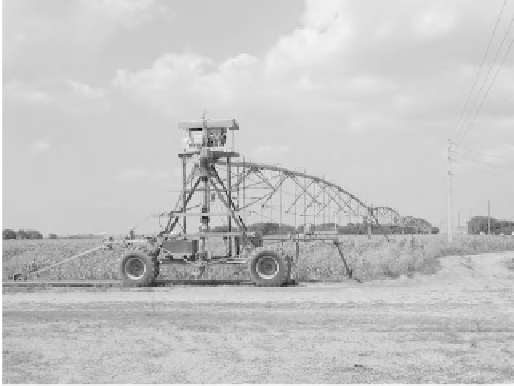Environmental Engineering Reference
In-Depth Information
5.2.4
Irrigation Return Flow
where
c
i
is the salt or contaminant concentration in the
water or wastewater used for irrigation (mL
−3
),
Q
i
is the
amount of irrigation water also including precipitation
that is not lost as surface runoff (L3T−1),
3
T
−1
),
c
aq
is the salt or
contaminant concentration of water percolating from
the root zone downward (mL
−3
), and
Q
e
is the amount
of water extracted from the soil by ET (L3T−1).
3
T
−1
). The
amount of excess irrigation water that has to be applied
to control salt or contaminant buildup in soil depends
on the tolerance of a crop to salt in the soil water, the
salt content of the irrigation water, ET rate, crop uptake,
and other losses from the system. The
leaching ratio
,
Q
i
/
Q
e
, is derived from Equation (5.1) as
Using water that is high in dissolved solids to irrigate an
area causes a portion of the irrigation water to be
returned to the atmosphere by evapotranspiration (ET),
and since evapotranspired water has no salt content,
there is a subsequent salt and contaminant buildup in
soils. At the very least, increased concentrations of dis-
solved solids in the irrigation water is a consequence of
evaporation. The portion of the irrigation water returned
to the atmosphere may range from less than 20% in
high-rate application systems in humid climates to
almost 100% in low-rate application systems in arid and
semiarid climates. Figure 5.4 illustrates a commonly
used type of mobile irrigation system that derives the
irrigation water from groundwater. The pump is shown
at the apex of the mobile support, and the sprinkler
nozzles are located between the supports.
To maintain acceptable salt content in soils and to
sustain crop growth and fertility of the soils, excess irri-
gation water must be applied if natural precipitation is
not sufficient to control salt buildup in soils. The excess
irrigation water, containing increased salinity and leach-
ate from soils, is either collected by subsurface drainage
systems or percolates directly into the groundwater. The
irrigation water collected by subsurface drainage
systems or leached into the groundwater is called
irriga-
tion return flow
and represents one of the more serious
problems associated with diffuse pollution of ground-
water. The concentration of salts in water percolating
through the soil root level into irrigation return flow or
to groundwater can be computed using the following
relation
c
Q
Q
i
aq
(5.2)
=
c
−
c
e
aq
i
The salinity of irrigation water is usually expressed
as conductivity in microsiemens per centimeter
(1000
µ
S/cm ≈ 640 mg/L·m of total dissolved solids
[TDS]). The salt tolerance of crops ranges from less
than 500
µ
S/cm for salt-sensitive crops, such as most
fruit trees and some vegetables (celery, strawberries, or
beans) to more than 1500
µ
S/cm for salt-tolerant crops,
such as cotton, beets, barley, and asparagus. most
common grain crops and vegetables have medium toler-
ance (500-1500
µ
S/cm) to salts. The
leaching require-
ment
(LR) is defined by
EC
EC
c
c
i
i
LR
=
=
(5.3)
aq
aq
where
EC
i
is the electric conductivity of irrigation water
and
EC
aq
is the electric conductivity of drainage water.
Combining Equations (5.2) and (5.3), the leaching ratio
can be expressed in the form
c Q c Q Q
i
=
(
−
)
(5.1)
i
aq
i
e
Q
Q
1
i
=
(5.4)
1
−
LR
e
The leaching ratio gives a measure of the amount of
irrigation water in excess of the ET requirement that
must be applied yield a leachate with concentration
c
aq
of salt or contaminant. The
irrigation efficiency
is equal
to the amount of water applied that is used for ET, equal
to the inverse of the leaching ratio. Typically, the LR to
maintain an acceptable quality of return flow is around
10% (Bouwer, 2002), corresponding to an irrigation effi-
ciency of around 90%. Such high irrigation efficiencies
can be achieved with sprinkler or drip systems. most
agricultural irrigation systems use flooding methods like
borders or furrows, which have lower irrigation efficien-
cies, typically in the range of 50-80%. This method
Figure 5.4.
Irrigation system using pumped groundwater.




Search WWH ::

Custom Search